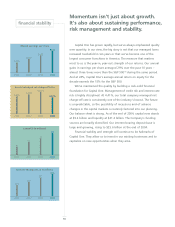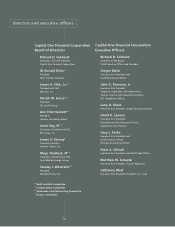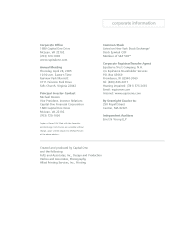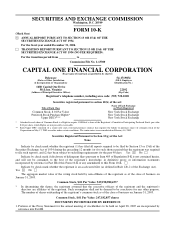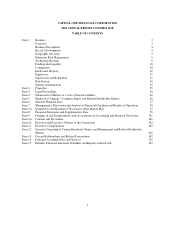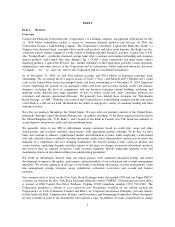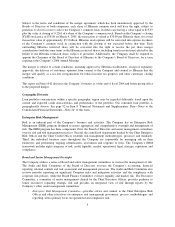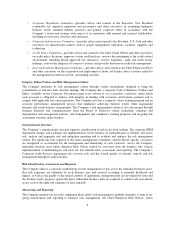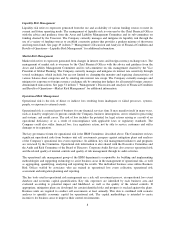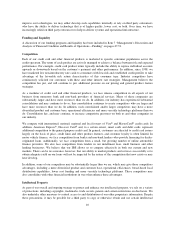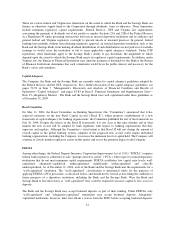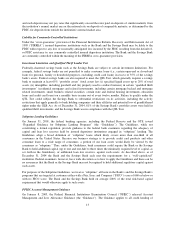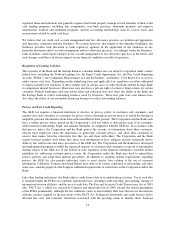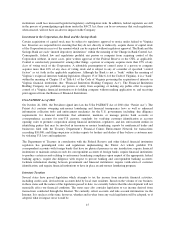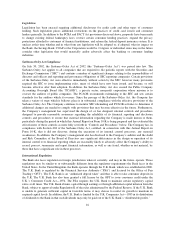Capital One 2004 Annual Report Download - page 29
Download and view the complete annual report
Please find page 29 of the 2004 Capital One annual report below. You can navigate through the pages in the report by either clicking on the pages listed below, or by using the keyword search tool below to find specific information within the annual report.•Corporate Reputation Committee—provides advice and counsel to the Executive Vice President
responsible for corporate reputation and governance and other executives in examining legitimate
business needs, standard industry practices and general corporate ethics in accordance with the
Company’s vision and strategy with respect to its reputation with internal and external stakeholders,
including its associates, investors and customers.
•Corporate Infrastructure Committee—provides advice and counsel to the President, U.S. Card and other
executives on infrastructure matters such as people management, operations, facilities, suppliers and
technology.
•Credit Policy Committee—provides advice and counsel to the Chief Credit Officer and other executives
on credit policy decisions; approves certain credit policies; reviews data pertaining to the credit control
environment, including Board approved risk tolerances; reviews regulatory, audit and credit review
findings; assesses the adequacy of corrective actions; and provides direction on credit risk management.
•Asset and Liability Management Committee—provides advice and counsel to the Chief Financial Officer
and other executives on the acquisition and deployment of funds, off-balance sheet activities related to
the management of interest rate risk, and trading activities.
Integrity, Ethical Values and Risk Management Culture
The Company maintains its risk management culture through various mechanisms designed to bring the
consideration of risk into daily decision making. The Company has a corporate Code of Business Conduct and
Ethics, available on the Corporate Governance page of its website at www.capitalone.com/about, under which
each associate is obligated to behave with integrity in dealing with customers and business partners and to
comply with applicable laws and regulations. The Company also has a corporate values training program and an
associate performance management process that emphasize achieving business results while maintaining
integrity and sound business management. The Company’s risk management culture is also encouraged through
frequent direction and communications from the Board of Directors, senior leadership, corporate and
departmental risk management policies, risk management and compliance training programs and on-going risk
assessment activities in the business.
Organizational Structure
The Company’s organizational structure supports consideration of risk in decision making. The corporate ERM
department designs and facilitates the implementation in the business of methodologies to identify and assess
risk, analyze and aggregate risk and mitigation reporting and to evaluate and enhance the risk management
culture. For significant risks reported to the senior management committees and the Board, specific executives
are designated as accountable for the management and monitoring of each such risk. Across the Company,
individual business areas utilize Business Risk Offices staffed by associates from the business who oversee
implementation of methodologies and tools for risk identification, assessment and reporting. The Company’s
Corporate Audit Services department also assesses risk and the related quality of internal controls and risk
management through its audit activities.
Risk Identification, Assessment and Response
The Company utilizes a corporate methodology for the management of risk across the individual business areas.
Key risk exposures are identified by each business area and assessed according to potential likelihood and
impact, as well as, the quality of the related controls. If appropriate, mitigation plans are developed for risks and
the business tracks progress against the plans. Individual business units are required to conduct self assessments
across each of the eight risk categories at least annually.
Monitoring and Reporting
The Company monitors its key risks, mitigation plans and its risk management capability through a system of on-
going measurement and reporting to business area management, the Chief Enterprise Risk Officer, senior
6


